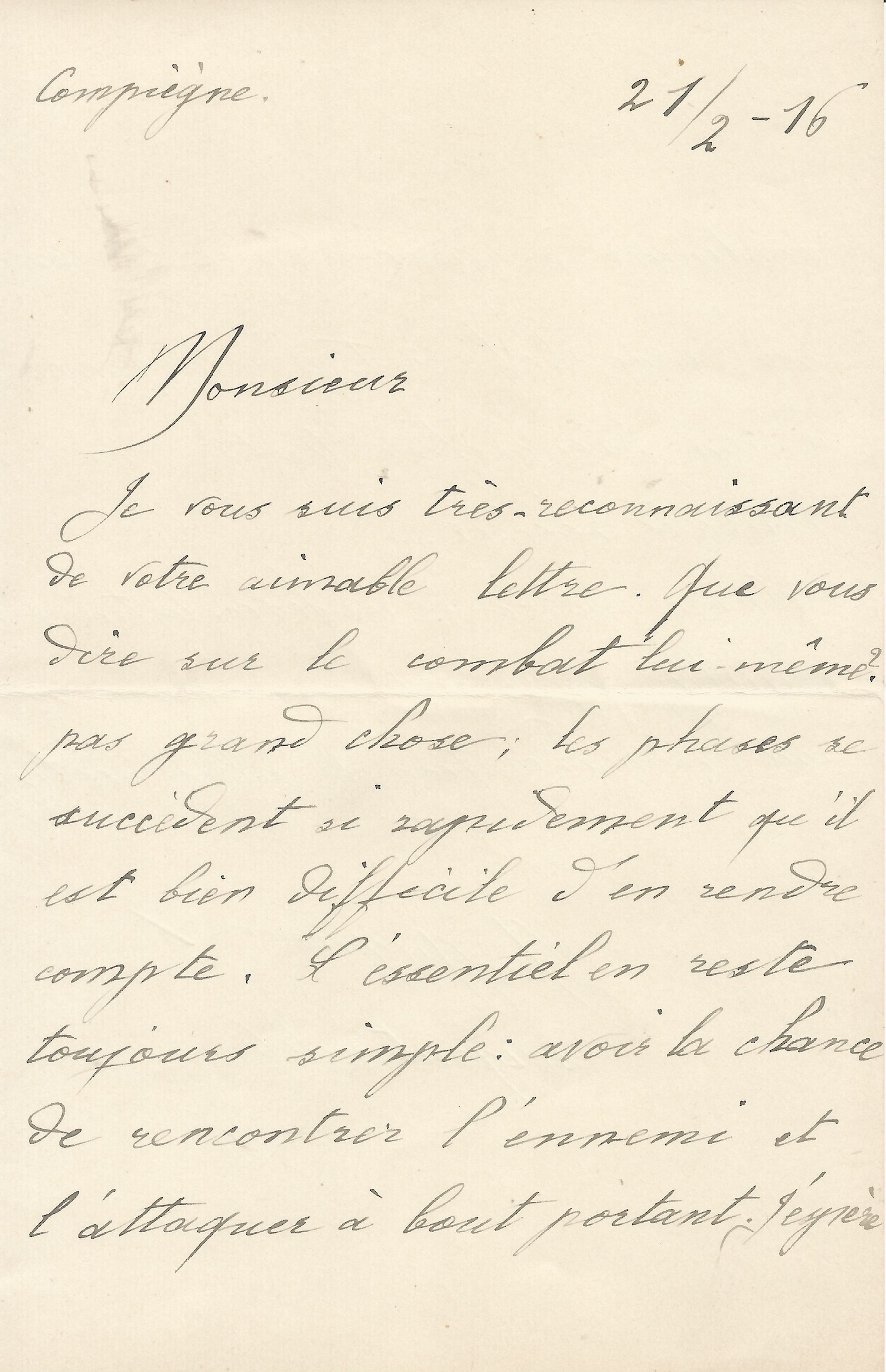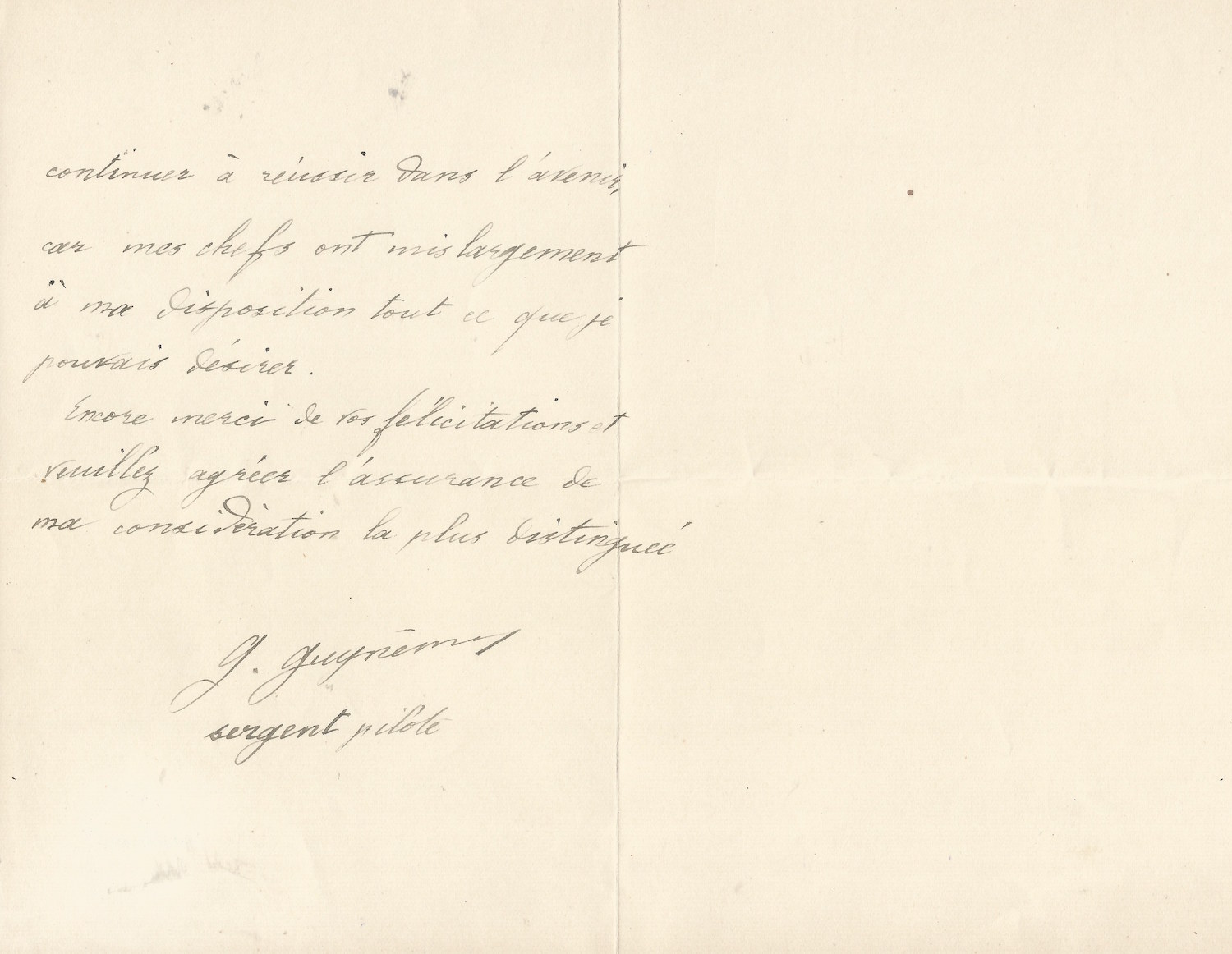Georges GUYNEMER (1894.1917)
Signed autograph letter.
Two pages in-8°. Compiègne. February 21 [19]16
» The main thing always remains simple: have the chance to meet the enemy and nevertheless attack him completely. “
Very rare letter from the French pilot, a few days after obtaining his flying ace status, testifying to his fierce determination to fight the enemy in the skies of the First World War.
_________________________________________
Sir, I am very grateful to you for your kind letter. What can I say about the fight itself? not much ; the phases follow one another so quickly that it is very difficult to account for them.
The main thing always remains simple: have the chance to meet the enemy and nevertheless attack him completely. I hope to continue to succeed in the future because my bosses have made everything I could want abundantly available to me.
Thank you again for your congratulations and please accept the assurance of my highest consideration. G. Guynemer, pilot sergeant.
_________________________________________
When the war broke out in August 1914, Georges Guynemer, a brilliant nineteen-year-old student, twice had his requests for recruitment refused by military medicine due to his weak constitution.
His tenacity won out on November 23, 1914, when he managed to enter the Pau aviation school, first as an assistant mechanic, then as a student pilot, hired for the duration of the war. Certified pilot in April 1915, he was assigned in June to squadron number 3, that of the Storks , where he first carried out reconnaissance missions, before delivering his first victorious aerial combat on July 19.
Promoted to sergeant and decorated with the military medal, Guynemer had a string of victories from December 1915. His successes, at Verdun, on the Somme, or during the Chemin des Dames offensive, led him, at less than twenty-three years old, to the rank of captain.
Remaining anonymous during his first year of combat, Guynemer gained notoriety on February 6, 1916 (a few days before this letter), the date of his fifth victory which earned him the title of flying ace. He was then the first to benefit from the decision of the General Headquarters which decided to disclose to the press the names of the victorious aviators. Over the following weeks, the pilot's portrait appeared on the covers of numerous newspapers: L'Illustration , Le Petit Journal , L'Excelsior , Le Pays de France , etc.
On September 11, 1917, at 8:30 a.m., Guynemer took off for a new combat mission. Around 9:25 a.m., near Poelkapelle, Belgium, he saw a German observation plane and headed towards it. His wingman, Lieutenant Jean Bozon-Verduraz, noticed the approach of several German Fokkers and went to meet them. After dispersing them, he returned to the place where he had last seen his leader. He returns to base alone. Guynemer has disappeared. Neither the wreckage of his plane nor his body was found.
On October 19, 1917, the Chamber of Deputies gave a new dimension to the hero, by unanimously adopting a resolution so that the memory of Guynemer be perpetuated in the Pantheon.
The Salon-de-Provence Air School has adopted Guynemer's motto: “Face face” and the Air Force evokes his memory every September 11 by taking up arms on its air bases. On this occasion the last quote from the hero is read: “Died on the field of honor on September 11, 1917. Legendary hero, fallen in the full sky of glory, after three years of ardent struggle. Will remain the purest symbol of the qualities of the race: indomitable tenacity, fierce energy, sublime courage. Animated by the most unshakeable faith in victory, he bequeathed to the French soldier an imperishable memory which will exalt the spirit of sacrifice and provoke the noblest emulations . »
_________________________________________
Bibliography: Agnès Chablat-Beylot – Archives de France.


